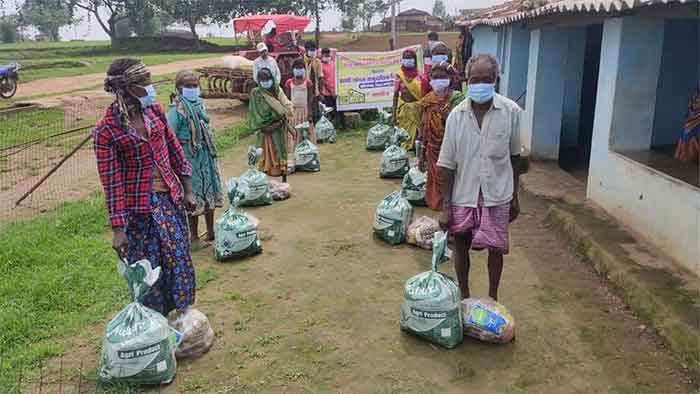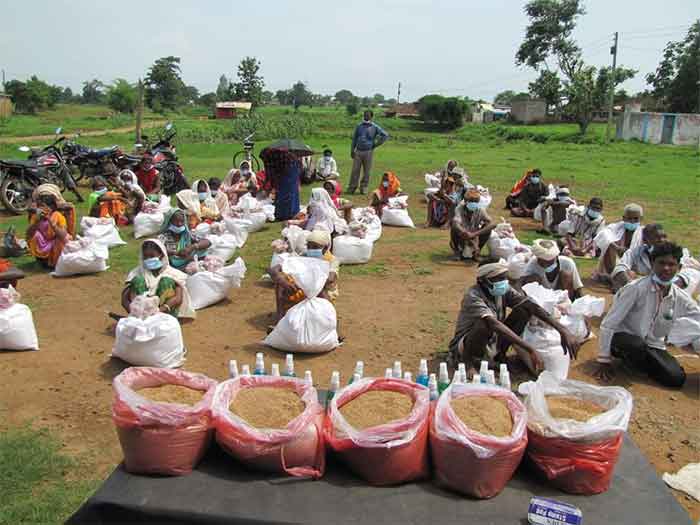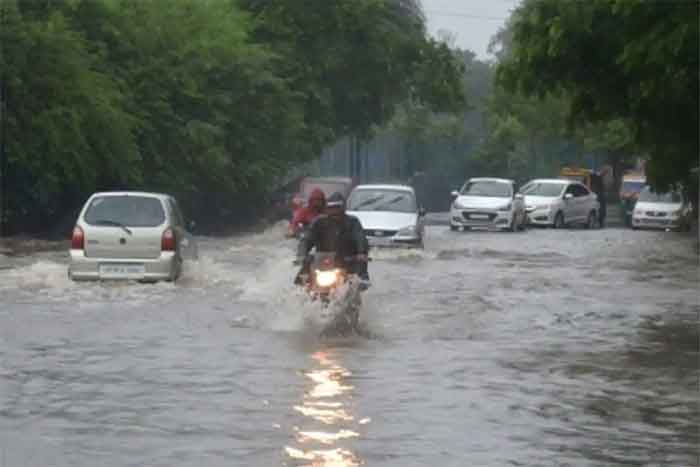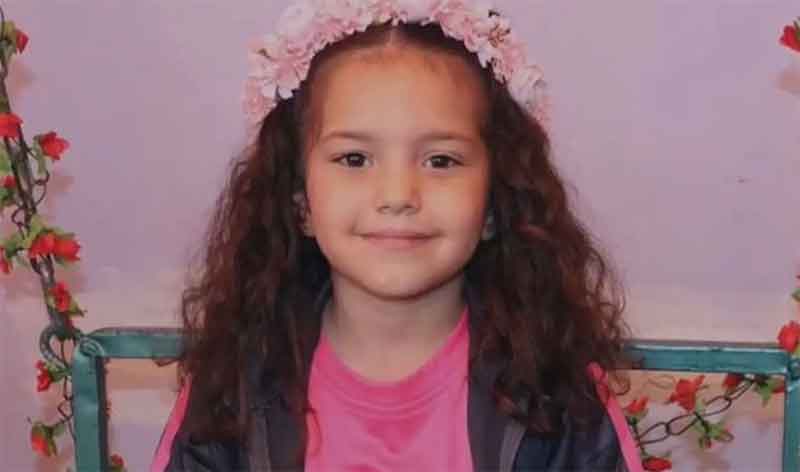With no income and all life at a standstill poor families around India have struggled to put together a square meal every day during the second wave of the Covid pandemic. With the government absent, many small voluntary and citizens groups stepped in to distribute rations consisting of cereals, pulses, oil, salt and sugar.
In the Dindori district of eastern Madhya Pradesh, bordering Chhattisgarh one social group working among Baiga Adivasis however decided to go a step further. Instead of giving wheat flour or rice procured from the market it ensured that the tribal folk were provided their locally grown, traditional diet of coarse grains, called kodo (Paspalum scrobiculatum) and kutki (Panicum sumatrense).

“Kodo-kutki are said to be sugar-free, very nutritious and in much demand from rich families of big cities like Mumbai and Pune” says Naresh Biswas, leading the social group distributing food in the thickly forested Baigachak area where the Baigas live.
The Baigas are one of the particularly vulnerable Adivasi groups, spread across Chhattisgarh, Jharkhand, Bihar, Odisha, West Bengal, Madhya Pradesh and Uttar Pradesh. India is home to about 700 indigenous groups, such as the Baigas, with a population of 104 million, who constitute 8.6 percent of India’s population.
 “It is a pity that the Adivasi who is growing kodo-kutki is not able to feed it even to his own family’ says Biswas. According to him these millets were an integral part of the local daily diet, but in recent years, due to the high prices they fetch , they are exported to urban areas, where they are sold as highly nutritious but low carb health food. “While one kg of rice is available for Rs 30 to 32, the price of one kg of kodo-kutki in the market ranges from Rs 65 to 70” says Itbari Baiga, a farmer of Tilapidi village in the Baigachak area. The Baiga farmers of Baigachak sell the traditional millets in the market and bring home polished grain like wheat and rice from the state-run Public Distribution System shops, which are comparatively less nutritious.
“It is a pity that the Adivasi who is growing kodo-kutki is not able to feed it even to his own family’ says Biswas. According to him these millets were an integral part of the local daily diet, but in recent years, due to the high prices they fetch , they are exported to urban areas, where they are sold as highly nutritious but low carb health food. “While one kg of rice is available for Rs 30 to 32, the price of one kg of kodo-kutki in the market ranges from Rs 65 to 70” says Itbari Baiga, a farmer of Tilapidi village in the Baigachak area. The Baiga farmers of Baigachak sell the traditional millets in the market and bring home polished grain like wheat and rice from the state-run Public Distribution System shops, which are comparatively less nutritious.
Activists associated with Biswas’s group are distributing kodo-kutki to Baiga families not just so that they get enough food but also to ensure they get high nutrition and can withstand the Covid pandemic better. The two millets are known to provide high protein, dietary fibre, mineral and antioxidant content.

The group argues that the government machinery should also pay attention to the issue of quality of nutrition whenever they provide food supplies to the needy, instead dumping whatever is cheap and easy to procure through the public distribution system.
According to the Adivasis, eating just half the amount of kodo-kutki is enough to fill their stomachs as compared to the quantity of rice needed. This means that instead of distributing 20 kg of rice, only 10 kg of kodo-kutki would be sufficient to provide the same amount of nutrition. In this way, even after buying the more expensive kodo-kutki, the overall costs are roughly the same as for buying higher quantity of polished cereals. With the Covid pandemic destroying the livelihoods of hundreds of thousands of poor and low-income families, activists feel that hunger and malnutrition are likely to become very serious problems in the days ahead.
According to Food and Agricultural Organisation estimates 189.2 million people or 14% of the national population are undernourished in India. Every year, 7.6 million children die before they reach the age of 5, most of them from preventable or treatable illnesses. Malnutrition is an underlying cause of more than 35 percent of these deaths.
Malnutrition is particularly acute among Adivasi populations, with 4.7 million tribal children of India suffering from chronic nutrition deprivation. About 80 per cent of the 5 million chronically undernourished tribal children live in just eight states of Karnataka, Chhattisgarh, Gujarat, Jharkhand, Madhya Pradesh, Maharashtra, Rajasthan and Odisha.
Those distributing kodo-kutki to the Baiga Adivasis are advising them to stop selling the coarse grains and use it for themselves as it is good for their health. They are also being encouraged to cultivate more of the crop, which is drought-tolerant and suitable for marginal soils. They can be also be produced with low input costs without any chemicals.
“The method of farming used to grow kodo-kutki and other similar crops is dying out” says Gothia Baiga, a resident of Talai Dabra village in Baigachak area.
According to him earlier many types of seeds were grown simultaneously in the same field and this was reflected in the variety of food on the plates of the local people. But, with the new, chemical and energy intensive farming, which also typically involves growing only one type of crop in the same field, the diversity of food has gone down and also changed local eating habits.
“Natural farming producing nutritious cereals should be promoted in the tribal areas where children are malnourished or women are anemic in large numbers” says Naresh Biswas. He feels that this will help the people solve their nutritional and other problems locally, without having to depend on government support. “Earlier we did not have to go to the market for anything except salt and clothes, because we could get almost everything we needed from the forest” says Gwalin Bai of Talai Dabra village in Baigachak.
This is the reason why Gwalin Bai and many other Baigas like her have been involved in a unique campaign for the last eight-ten years to save their seeds. Under this initiative, heads of the Baiga community are distributing many varieties of indigenous seeds to each other through their panchayats for natural farming and also setting up seed banks in the villages. In Gwalin Bai’s opinion “If we save our seeds, we can start producing our traditional crops in abundance”
At the same time, Naresh Biswas explains that in order to promote traditional farming and nutritional security based on natural farming, apart from kodo-kutki, many other varieties of coarse grains are also available with the Baiga community, such as sawa, selhar and mandia. Some of these varieties of grains are so nutritious that Baiga also use them as medicines.
During the recent Covid lockdown the Baigas have also been returning to the forest to fulfil their dietary needs. Naresh Biswas explains that when the markets remained closed and the Baiga found it difficult to get green vegetables they were forced to use a variety of fruits, flowers, roots and leaves from the forest in their daily food. The Covid crisis it seems has compelled the Baigas with no choice but to return to their roots. Both literally and metaphorically.
Shirish Khare has been associated with rural journalism for a long time and has been continuously reporting on the economic, social and health impacts of rural life during the Corona pandemic.











































